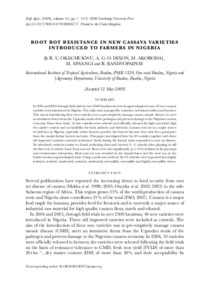| dc.contributor.author | Okechukwu, R.U. |
| dc.contributor.author | Dixon, Alfred G.O. |
| dc.contributor.author | Akoroda, M.O. |
| dc.contributor.author | Mwangi, M. |
| dc.contributor.author | Bandyopadhyay, Ranajit |
| dc.date.accessioned | 2019-12-04T11:15:10Z |
| dc.date.available | 2019-12-04T11:15:10Z |
| dc.date.issued | 2008 |
| dc.identifier.citation | Okechukwu, R.U., Dixon, A.G.O., Akoroda, M.O., Mwangi, M. & Bandyopadhyay, R. (2009). Root rot resistance in new cassava varieties introduced to farmers in Nigeria. Experimental Agriculture, 45(1), 15-24. |
| dc.identifier.issn | 0014-4797 |
| dc.identifier.uri | https://hdl.handle.net/20.500.12478/2930 |
| dc.description | Published online: 01 January 2009 |
| dc.description.abstract | In 2004 and 2005 through field trials in over 2500 locations in several agroecological zones, 40 new cassava varieties were introduced in Nigeria. The trials were managed by scientists, extension workers and farmers. The aim in introducing these new varieties was to pre-emptively manage cassava mosaic disease, to avert an imminent threat from the Ugandan strain of the pathogen and prevent damage to the Nigerian cassava economy. From these trials, 10 new varieties were selected and officially released for high root yield, high dry matter content and acceptability for food, industry and livestock. Cassava root rot is a major source of yield loss in Nigeria, especially where farmers practice late harvest because they wait for a good price from the market before harvest and sales. This paper investigated how the 40 varieties together with three old improved varieties currently in farmers' fields during the formal trials responded to root rot disease. No absolutely resistant variety was found, indicating that early harvest (9–11 months after planting) is still the best way to reduce losses from root rot. Root rot is also significantly (p ≤ 0.05) influenced by genotype and environment interaction. Most root rot was recorded in the humid forest and the least was in the Sudan savanna agroecological zone. Using a rank-sum method, the 43 varieties were separated into highly resistant, resistant, moderately resistant, moderately susceptible, susceptible and highly susceptible classes. |
| dc.language.iso | en |
| dc.subject | Agroecological Zones |
| dc.subject | Cassava Varieties |
| dc.subject | African Cassava Mosaic Virus |
| dc.subject | Pathogen |
| dc.subject | Susceptible |
| dc.subject | Genotypes |
| dc.subject | Root Rot Disease |
| dc.title | Root rot resistance in new cassava varieties introduced to farmers in Nigeria |
| dc.type | Journal Article |
| dc.description.version | Peer Review |
| cg.contributor.affiliation | International Institute of Tropical Agriculture |
| cg.contributor.affiliation | University of Ibadan |
| cg.coverage.region | Africa |
| cg.coverage.region | West Africa |
| cg.coverage.country | Nigeria |
| cg.authorship.types | CGIAR and developing country institute |
| cg.iitasubject | Genetic Improvement |
| cg.iitasubject | Plant Breeding |
| cg.iitasubject | Cassava |
| cg.iitasubject | Plant Production |
| cg.iitasubject | Post-Harvesting Technology |
| cg.iitasubject | Plant Genetic Resources |
| cg.iitasubject | Farming Systems |
| cg.iitasubject | Food Security |
| cg.iitasubject | Plant Diseases |
| cg.iitasubject | Disease Control |
| cg.iitasubject | Pests Of Plants |
| cg.iitasubject | Handling, Transport, Storage And Protection Of Agricultural Products |
| cg.iitasubject | Farm Management |
| cg.accessibilitystatus | Limited Access |
| local.dspaceid | 94031 |
| cg.identifier.doi | http://dx.doi.org/10.1017/S0014479708006777 |

